Send this article to a friend:
February
18
2023
Send this article to a friend: February |
What’s Hiding Behind the “Disinflation” Smoke and Mirrors?
For example, “Here’s where inflation is easing,” a piece on recent Bloomberg article claimed. (Yes, you do have to look rather closely to find examples.) “The disinflationary process has begun,” Chairman Powell announced to various media outlets. “The strongest economy in history!” President Biden keeps repeating. Well, older Americans aren’t buying it. (Nor should they). Now, I’m a fan of positive economic news, except when it’s imaginary. I do not appreciate being smoke-screened or gaslit for any reason, especially for a political reason. I assume you’re the same way, and prefer the real story over the feel-good, fake-it-till-you-make-it propaganda flooding the airwaves. So let’s take a moment and examine the real inflationary picture. We’ll start with commentary on the most recent official report:
Looks to me like prices went up on popular consumer goods, and wages went down. Inflation is still running hotter any time in the last 30 years. That’s what you and I see, but that’s not the whole story. Upstream of consumer prices is producer price inflation (PPI), which measures the costs of commodities required to produce finished goods – everything from appliances and cars to furniture and clothes. We watch PPI because it indicates prices at a manufacturer level. When those rise, guess who gets stuck with a higher price tag? That’s right, we do. The news isn’t good on that front, either:
Producer prices tend to be sticky. Companies tend to raise prices when costs force them to, but vastly prefer to leave prices higher until competition or demand destruction forces them to act. Bill Smead, chief investment officer at Smead Capital Management, thinks that inflation is “stickier” than the Fed, Biden administration or Treasury Department are willing to admit:
Keep in mind that Smead’s prediction only describes what could be possible over the next ten years. Unfortunately, the situation is already getting worse right now, featuring yet another installment in the long cavalcade of Fed faux pas… Disappearing “disinflation” Occasionally, the Bureau of Labor Statistics (BLS) will re-examine their data releases, then revise them if necessary. In this case, that “disinflation” which earned so much attention recently is fading fast… Here’s Wolf Richter’s take on BLS revisions to December’s inflation numbers:
Can Fed Chairman Powell really say that a disinflationary process has begun? Maybe he was looking at the same wrong numbers as everyone else – even so, to continue making the claim, in the face of more accurate data? That doesn’t make any sense. Rather than moving the goalposts, it seems like the Fed is just insisting they scored a touchdown even though instant replay footage proves they’re wrong. What’s next? Probably moving the goalposts… We must “learn to live with 3-4% inflation” For years, the Federal Reserve has maintained a targeted inflation rate of 2%. Maybe not for much longer. Mohamed El-Erian, chairman of Gramercy Funds, recently told Bloomberg Television bad news about the Federal Reserve’s historic inflation target:
The end of cheap and easy money? No wonder tech companies have cut over 15,000 jobs a week since the beginning of the year alone. If El-Erian is right, Wall Street will have a lot of trouble adjusting to assets based on their intrinsic, fundamental value. That means asset prices would very likely tumble. Kenneth Rogoff, a former Fed economist, recently agreed with that assessment:
Think about this for a minute. This is an economist who worked for the Federal Reserve. (He’s also an author with an impressive body of research behind him.) He’s telling us the following: “Higher real rates will mean lower asset prices in general.”The more speculative, the riskier assets are, the farther and faster they’ll respond to higher interest rates. By “respond” I mean fall, plummet, plunge, decline, tumble and fall. Just as absurdly low interest rates fuel a bubble, the return of even marginally reasonable interest rates pops the bubble. Excuse me – I should say “disinflates” the market bubble. I conclude that the next decade will be rough going for those of us seeking long-term financial security. Here’s the bottom line: When times are crazy, “normal” plans probably aren’t enough. Staying stable in volatile and uncertain times There are a number of strategies to consider while planning your long-term financial stability (especially in retirement!) for a rough ride. I’ll tell you this for free: hoping it will all return to normal isn’t one of them. It might be a good time to consider the benefits of wealth preservation rather than growth. To borrow Mark Twain’s memorable turn of phrase:
He’s right! The more speculative and volatile any asset is, the more likely it is to go to zero — and stay there. For those concerned about “return of” your money, physical gold has proven to be a safe-haven store of value. Especially during longer periods of economic turmoil. For example, during the 1970s inflationary period and oil crisis, gold prices gained over 2,000%over the course of the decade. That doesn’t mean the price of gold or silver will spike like that this time, but it’s still a possibility. It’s happened before. That’s why investors consider both gold and silver as safe haven investments that hedge against market chaos. If you think that kind of wealth preservation over time sounds like a good idea, perhaps it’s time to take a few minutes and learn even more.
|
Send this article to a friend:
 |
 |
 |